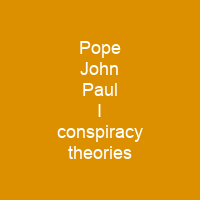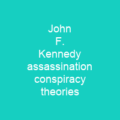Pope John Paul I died suddenly in September 1978, 33 days after his election. Following contradictory reports about the circumstances of his death, several conspiracy theories have gained currency. Many of these concern the serious corruption in the Vatican Bank, possibly linked to Freemasonry, which is forbidden by church law. None of the claims has been substantiated.
About Pope John Paul I conspiracy theories in brief

In God’s Name proposed the theory that the pope had been in ‘potential danger’ because of corruption in Vatican Bank. There is a papal ban of Freemason, and it is forbidden for a Roman Catholic to be a Freemason. Yallop agreed to donate every penny he made from sales to a charity of the Vatican’s choice if they agreed to investigate his central claim, that when the body of the pope was discovered, his contorted hand gripped a piece of paper that was later destroyed because it named high-ranking members of the curia who were Freemasons and others who had a role in numerous corruption scandals and the laundering of mafia drug money. In his book A Thief in the Night, British historian and journalist John Cornwell examines and challenges Yallo’s points of suspicion. He bases this, inter alia, on an early report by Italian news service ANSA that garbled the time and layout of the papal apartments. The Cornwell transcripts show that the Vatican refused to show his transcripts to show this effect.
You want to know more about Pope John Paul I conspiracy theories?
This page is based on the article Pope John Paul I conspiracy theories published in Wikipedia (as of Jan. 08, 2021) and was automatically summarized using artificial intelligence.







